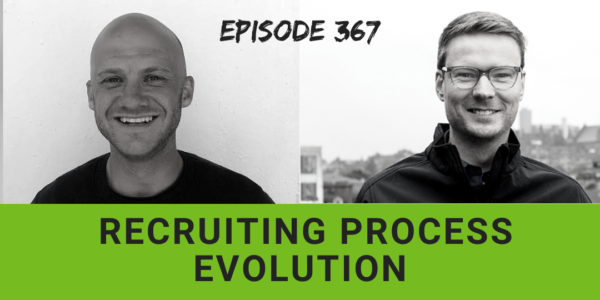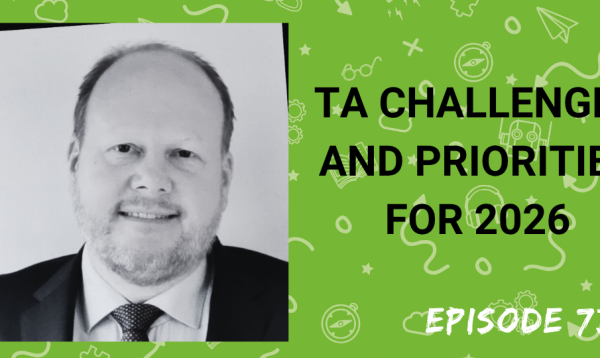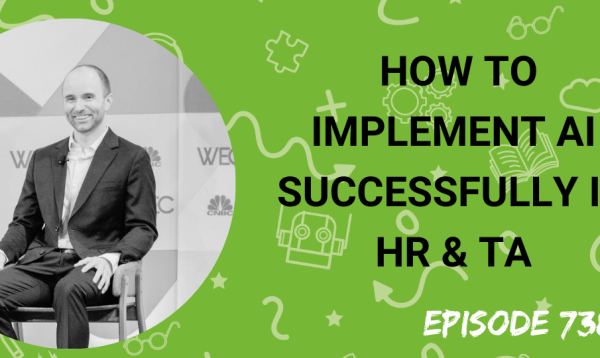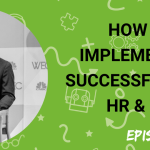For many employers, the move to virtual recruitment processes was an unplanned one. Eighteen months from the initial shock, though, long-term benefits are emerging, and it is clear that the recruiting process is evolving permanently and irreversibly. It is essential that talent acquisition professionals understand this change and support it with technology that is fit for the new purpose.
This week’s guests are Tom Pugh-Jones, Partner at Pentire Group and Euan Cameron, CEO at Willo. Tom has used technology to evolve processes and transform his local recruitment business into an operation that leverages a global talent pool to serve an international client base. Euan is an entrepreneur building the technology that has helped Tom make such a quantum leap forward with his business.
In the interview, we discuss:
• The challenges of the traditional interview process
• Accessing global talent pools
• The candidate and hiring manager experience
• Why specialist software is essential
• The power of asynchronous working
• The current state of talent markets
• Prediction for the future of recruiting
Listen to this podcast in Apple Podcasts.
Transcription:
Matt Alder [00:00:00]:
Support for this podcast is provided by Willow, the One Way video interviewing platform. Speaking to candidates on Zoom Teams or Skype is a great way to meet people, but it can also be exhausting, inefficient and inconvenient. Willow has taken the interviewing process and brought it into the 21st century. They looked at all the negatives of traditional interviewing, like scheduling, fatigue, anxiety and travel, and created a virtual interviewing process that candidates actually love. And they have the NPS score to prove it. With Willow, you simply write a series of questions that you want candidates to answer, then share the link with them. They then answer your questions in their own time on any kind of device or browser. The company has a real focus on making the process easy and making it feel as candidate friendly as possible. They also have native integrations with Workable Greenhouse and Zapier so you can automate your selection process, cast a wider net and and really scale things up. Willow offers a totally free version that allows you to trial their approach to video interviewing for as long as you need to, and then when you do want to upgrade, it’s genuinely affordable and they’ll even plant a tree for you to ensure that every interview is carbon neutral. Sign up for free at Willow Video. That’s W I L L O dot Video.
Matt Alder [00:01:42]:
Hi everyone, this is Matt Alder. Welcome to episode 367 of the Recruiting Future podcast. For many employers, the move to a virtual recruitment process was an unplanned one. Eighteen months on from the initial shock though, long term benefits are emerging and it’s clear that the recruiting process is evolving permanently and irreversibly. It’s essential that talent acquisition professionals understand this change and support it with technology that’s fit for the new purpose. This week’s guests are Tom Pugh Jones, Partner at Pentire Group, and Euan Cameron, CEO at Willow. Tom has used technology to evolve processes and transform his once local recruitment business into an operation that leverages a global talent pool to serve an international client base. Euan is an entrepreneur building the technology that’s helped Tom make such a quantum leap forward with his business. Hi, Euan. Hi, Tom. Welcome to the podcast. Could you just start by introducing yourselves and telling us what you do? Euan, why don’t you go first?
Euan Cameron [00:02:54]:
Thanks. Thanks, Matt. Well, it’s great to be on the show. My background is 15 years in digital marketing and really helping startups grow, taking them from 0 to 100 and getting their first sales online, but recently started up a recruitment technology company called Willow.
Matt Alder [00:03:13]:
Fantastic. Stefan. We’ll sort of talk much more about Willow as we go through the conversation. Tom, could you just introduce yourself and tell us what you do?
Tom Pugh-Jones [00:03:20]:
Yeah, sure. I’m Tom Pugh Jones and I’m a partner at the Pentire Group and specialize in SaaS sales recruitment. So helping high growth SaaS businesses build out their commercial teams. I’ve spent my whole career working in sort of sales marketing and recruitment. And yeah, we’re based down in the southwest in Cornwall and work globally.
Matt Alder [00:03:45]:
Fantastic stuff. And yeah, this is a really interesting conversation because Tom, you’re down in the sort of the far southwest of England in Cornwall and you. And you’re up in Scotland. So truly whole of the UK conversation today. I mean, Tom, tell us a little bit more about your story, your business, why you started it, why Cornwall, and a bit more about what you do.
Tom Pugh-Jones [00:04:07]:
Yeah, absolutely. So prior to setting up the Pentire Group, I had my own recruitment business down in the southwest, dealing with growing businesses in Cornwall. So a lot of it was local stuff and was great, but sort of realized actually there’s a big wide world out there and there’s some great businesses, so why don’t we just look at something a little bit different and started focusing on the SaaS market and sort of at the time we were actually quite concerned about our location, that we weren’t London centric or in a hub where there’s technology businesses. So we really sort of dug into our process and how we could eliminate not having to be in those hubs. And this was, this was actually pre Covid. So we were, we were looking at different technologies to use in order to, to streamline what we’re doing and provide a good service. And yeah, through that sort of stumbled across Euan at a very early stage and seeing what he was doing with Willow and here we got chatting and started to build that into our process.
Matt Alder [00:05:25]:
That’s really interesting stuff. So you were sort of going for, effectively going for virtual recruitment before it became the massive global, global trend, basically. I mean, talk us through. We’re obviously at this position now where people are starting to get back to the offices, people are thinking about what their recruitment processes might look like moving forward and what, what they’ve sort of learned from the last 18 months. I mean, what, what are your sort of views and experiences on the challenges of the sort of traditional interview experience, the kind of the face to face stuff that everyone was Doing before the pandemic.
Tom Pugh-Jones [00:05:57]:
One of the huge things is. Well, there’s a couple of things that seems fairly old fashioned, time consuming. One’s a cover letter, which people were really big on a couple of years ago. And I think new technologies have sort of eradicated this. There’s also the time that people spend going to and from interviews in multiple stage processes. And I think with the new technologies that are on offer and what’s been happening in the world, a lot of this has been eradicated, which has taken a lot of blockers out of the interview process.
Matt Alder [00:06:36]:
Absolutely. And so you. And I mean, tell us a little bit about why you started Willow and how you see the sort of challenges in traditional recruitment and how you’re sort of going about solving them.
Euan Cameron [00:06:48]:
Sure. So we started Willow back in 2018, but the reason that we started Willow was I was becoming frustrated with the way that candidates were actually being hired through the traditional interview process. So when we looked at the kind of the traditional interview process, you’re inviting people to an office, they’ve never been to the office before, most likely, and they’re sitting in front of someone they’ve just met, they’re getting asked a bunch of questions that have never been asked before. And I didn’t feel that this was right. I thought this was a really poor process. And I was obviously at the time asking candidates to go through this process to apply for roles. I was actually trying to fill in my previous marketing businesses. So it didn’t really sit well with me. So back in 2018, we decided, let’s try and change this up and make the interview process something that candidates actually want to do and enjoy doing. And obviously we could also see that there was a real shift towards remote work back then, although it was really early on, there was a real kind of shift in certain organizations who wanted to be leading and attract the best talent. They were going towards remote work back in 2017, 2018, anyway. So we knew that face to face interviews weren’t going to work in these remote businesses of the future. So that really spurred us on to create this interview process that not only candidates enjoyed using, but also the candidates could use remotely and the businesses could use remotely and they could continue to operate and hire at the same pace they were doing before or even more quickly. So that was really what kind of drove us to create Willow. I met up with my co founder and we kind of just redesigned this whole process and tested it throughout 2019 before launching it in January of last year. And it really, really the whole Point of kind of testing throughout that 2019 period was actually to make sure that this was a solution that was actually making the hiring experience better. Because that was one of the things we were really conscious of was that obviously lots of companies identify problems, lots of startups identify problems, but they don’t always solve the problem. They sometimes make the problem just look different. They start move some pieces around and create a different looking problem, but they haven’t really taken the problem away. So what we, what we were really conscious of was that we wanted to make this a better process. So we literally sat down with hundreds of candidates over the course of that year and asked them, if you were applying for a job or you were going to go into an interview, what would you want to happen and what would you not want to happen in that interview? And we used all that feedback and actually hopefully created the process that we have today which is, which is better for candidates and the employers.
Matt Alder [00:09:37]:
So, Tom, talk us through the process that you have and how technology is helping that, because I think it’s really interesting that you, by virtue of your location and your client base, you’re always going to be a remote business as far as the majority of your candidates are concerned. So, I mean, talk us through the processes. How does the technology work, what kind of results are you seeing from it and what do the candidates think?
Tom Pugh-Jones [00:09:59]:
Yeah, so we’re in sort of SaaS, sales recruitment, which is a fairly forward thinking sort of area of recruitment to be in anyway. So what we do find, if you’re a salesperson and you’re selling technology, you will have been used to prospecting in many different ways. You’d be used to demoing and closing all online, all through conferencing. So what we’ve found is once we’ve had a chat with the candidates, we’ve screened them ourselves, sold them on the opportunity, then we use the Willow video prescreening in a way that we can present our candidates in the best possible way, in a streamlined way for them to impress their potential employer. And it’s worked really well. We’ve used it from junior sales development representative opportunities all the way up to executive search CEO placements. And on each end of the scale, our clients are very happy with it. It saves them time and it also gives them a feel for the person without yet having to speak to them, which is very good for a busy executive.
Matt Alder [00:11:25]:
Absolutely. I was going to say, what do the hiring managers think of it? Euan, we actually first spoke, I think, just before you were launch Willow and obviously you did all that testing and then you launched it and the pandemic came along. I mean, what’s it been like launching and sort of scaling a new business during the pandemic? And how has that sort of really accelerated things for you with this massive move towards remote hiring?
Euan Cameron [00:11:53]:
Yeah, so we first spoke about two years ago now, which is crazy how quickly time flies. But I think in the past year a lot of things have changed for us. A lot of challenges have actually come along. So I guess the first challenge was actually that we launched in January of last year. We had a plan for the year and what the year was going to look like and we had to rip that plan up completely in March. We, for example, had a crowdfund campaign set up for April last year. And everyone that was advising us on that crowdfunding campaign said, pull your crowdfunding campaign, it’s not going to go ahead. People aren’t really thinking about investing in companies right now. So that was probably the first big hurdle for us we had obviously mapped out this year. We had a funding plan in place. We were quite optimistic about the crowdfunding and how that was going to go. And then we had to pull all of that. And it was a real change of pace because we wanted to continue doing what we were doing and obviously growing our customer base. But at the same time we didn’t have the funding lined up to enable us to do that. Fortunately we did later on in the year. So in August of last year raise a Pre seed of 250,000. But that was obviously a lot later on in the year than we planned. So it was a real curveball. But it’s also, it’s been a really good thing for what we do. So obviously video technology around the world has been used by everyone. Like there’s literally not a person probably in the world that hasn’t interacted with video conferencing or video technology in the past 18 months, which is a good thing for us. It’s a good thing for what we do. We’re estimating the adoption of video technology in the workspace has actually been accelerated by about five years due to Covid across all industries, which is amazing. Obviously Tom mentioned there that SaaS businesses tend to be more forward thinking and have used video technology. But on the flip side, there’s lots of industries where video technology had never been considered before. You know that there’s certain industries like manufacturing or you know, healthcare, where there was obviously talk of video but no one really embraced it. So Covid’s helped really throw that into the forefront and it’s been accepted culturally as a technology that we can use as well. You know, people in sort of, in the earlier years when we were testing and speaking about Willow and how video interviewing could have its place, often the objections were, you know, around I don’t feel comfortable on camera or I don’t actually have a camera or a microphone on my device. We had lots of people who didn’t have webcams. So all of that has really changed for the better as well. And we’ve seen obviously lots of hardware. It was impossible to buy a webcam in the, in the early days of COVID last year. So really a lot has changed, but hopefully for the better for obviously video technology and the technology that will is providing. So it’s been a bumpy old 18 months, but we’ve hopefully come out a little bit stronger than we went into the whole pandemic with obviously changes in just society and how we approach video.
Matt Alder [00:15:03]:
Yeah, I mean, absolutely. And I think we’re entering a very interesting time now because pretty much all employers had to embrace some kind of video based recruiting. So obviously lots of people have been using platforms like Zoom and Teams to do their interviewing. And I’m certainly aware that kind of really progressive, innovative employers are now sort of taking a step back and looking at the technology that they have and making sure, making sure it’s fit for purpose, basically. I mean, Euan, what would your sort of message be to people who’ve been using more sort of generic software for video interviewing? Why should they be thinking about you using specialist software as part of their process?
Euan Cameron [00:15:45]:
Sure. I love this question. So we get asked this obviously often because a lot of our customers are coming to us and saying, hey, we already use Zoom or we already use Teams. It’s working quite well for us. Why would we switch to a more specialist technology? The first answer really is that all of those platforms that we just spoke about, there are synchronous platforms. So the conversation between the candidate and the employer is happening in real time. And that’s like a, obviously a conversation. It’s fine, but it’s not particularly scalable. It’s one of the first problems that you have there. So you can only do obviously a certain number of Zoom interviews a day and you only want to do a certain number of interviews a day because they’re quite hard work. Obviously there tends to be a small lag between when you speak and when the person answers. And when you’re trying to do that all day. It can become quite exhausting. And we speak about Zoom fatigue and things setting in. So I think that the first real difference is that those synchronous platforms we speak about are not scalable when you want to do lots of interviews. The other, I guess, disadvantage of using one of those platforms is that you actually have to schedule and set up these interviews ahead of time. So, for example, I have like 10 candidates. I want to interview them all. I have to obviously go into my diary, arrange times that work for them and for me, and then send out invitations. All of that stuff takes a lot of time. And time is really the biggest thing that we focus on when we’re speaking about Willow to new customers, because the time saving element is actually insane. We’re talking hours of time lost to scheduling and setting up these interviews, which in the early days of COVID was fine, when maybe you weren’t hiring that many people or you were just getting used to technologies and everything was new and it was maybe a bit more exciting. But as we move into, obviously, bigger hiring cycles and bigger hiring processes, it just doesn’t become scalable anymore. And that’s, I guess, the biggest problem that we’re kind of addressing here. So Willow is a completely asynchronous platform. And what that means is, rather than me asking you questions and you responding a couple of seconds later, the Willow platform is actually asking the questions and the candidate is answering them when they’re ready. So they read the questions on the screen and then they’re recording their answers and the real difference that it creates from a candidate perspective. So we spoke about the employer’s sort of advantages there, but from a candidate perspective, the real advantages are that they are in control. So they can actually do that interview whenever they want and wherever they want. They can also do it on any device that they want to use as well. So the real kind of the advantages are on both sides. And when you use a specialist technology like Willow, you’re really saving a lot of time. You’re able to do multiple interviews at once. For example, we have customers that will invite 100 candidates to a Willow interview at the same time. And those candidates will then all start their interviews in a couple of hours later. So they can actually be doing simultaneous interviews, which is really exciting when you think about what that enables employers to do. But then on the flip side, it is giving the candidates the control, giving the candidates a technology as well that’s easy to use. We often hear from customers that are using Zoom, for example, that candidates can’t get into Zoom and that’s not a great start to an interview for any candidate. You don’t want to be sitting struggling and stressing about the technology just to speak to an employer. It just doesn’t seem like a great starting point for anyone. So there’s obviously real advantages for both parties. And then the final thing that I’ll add to this, Matt, is really that when you do interviews on Zoom or teams, they typically aren’t recorded. And that kind of takes away a lot of the advantages of video technology and technologies and recruitment in general. The fact that Willow is asynchronous means that it’s always recorded video. And recorded videos have a huge advantage that you can actually share those with other people. So you can share interviews with your team. So you might be doing a collaborative hiring process, and you can share those videos with your team. You could also, obviously, what Tom mentioned earlier, you can share those videos with your clients, and your clients can come back and give you feedback. So it really helps kind of make a more inclusive hiring process, which, again, is really beneficial for both parties, actually.
Matt Alder [00:20:20]:
And, Tom, interested in your thoughts on that in terms of recruiting and candidate communication, moving to this asynchronous approach, I mean, how’s that been for you?
Tom Pugh-Jones [00:20:31]:
It’s been great, because once they’ve done it, also it’s evergreen. So you can choose on the search whether you want to have sort of general questions that stay the same, or you can really tailor them to your client’s search. Then if you keep them sort of uniform, you’ve not only just got somebody doing a video for one employer, you could potentially put them in front of five or six. There’s a real sort of scalability piece of actually putting good candidates in front of employers, or if the candidate’s happy even to put them in front of people that you’re prospecting. And it can be a great business development tool as well. So you’ve got lots of opportunities to streamline things, and people are familiar with candidates you’re putting in front of them without having to go through a boring cover letter and then try and find a time to have an initial call and then get feedback on that. And yeah, as Euan said, people can share it with their team, and it gives a really good snapshot of a person before having to jump through all of the administrative hoops and scheduling and organizing interviews.
Matt Alder [00:21:54]:
And I just want to ask a couple of questions, a couple of more general questions that I’m really sort of asking everyone on the podcast at the moment. Firstly, about the supply and Demand of talent in the, in the market at the moment, what we seem to be seeing all around the world in lots of different markets are skill shortages. Very, very difficult to, to, to recruit people. Tom, what are you seeing in the, in the market that you work in? What’s it like out there?
Tom Pugh-Jones [00:22:18]:
It’s an incredibly interesting time at the moment, Matt, because you’ve got, we, you’ve got, yeah, you’ve got a serious demand for software salespeople. A lot of people are looking at, you know, they need the experience, they have to be smashing quota and all the rest of it. There’s a couple of ways that people are getting better at this, especially with the very forward thinking companies. They’re looking into their, their revenue acceleration, their LMD and their sales enablement in huge ways just to make it easy to train and ramp up salespeople in a, in a fast, efficient manner and then very much looking into their technology stacks and their revenue operations. So finding the most simple and effective way with reduced barriers to help these people get up to speed. But from like a talent perspective, everything is becoming borderless. So you could have opportunities in London, Berlin, San Francisco, where the companies are based, but now you can employ people from anywhere in the world. And I mean there’s, there’s one client specifically that we’re working with at the moment that is just not taking people from hubs or from like city hubs, where, where these big technology businesses are from. And I think that on a, on a sort of global scale, sort of almost like democratizing opportunities around the world. So I think yes, there is a skills shortage at the moment, but sort of five to 10 years down the line, you’ll see people working in, well, if they, you know, if they can work with the Internet, they can have, you know, a really successful career from wherever they are in the world. So from a, from a short term perspective, there’s, there is a global shortage in the talent that we’re looking at. But if we’re looking mid to long term, I think the opportunities are huge.
Matt Alder [00:24:25]:
Euan, you obviously work across a number of different markets. What are you hearing from your other customers?
Euan Cameron [00:24:29]:
So it’s really interesting. I think Tom really just almost stole the words out of mouth. We’ve seen really similar things across the different industries that we operate in. Volume of candidates. Obviously shortage of candidates is number one on the agenda for the majority of our customers. But also the quality of the candidates is high on the agenda and actually trying to get access to the highest quality candidates they can. And I guess to echo Tom’s point there, customers are really looking further afield than ever before for the right candidate, which is extremely exciting, I think, for society. Just in general, the fact that the businesses are looking to hire wherever that person is is awesome. I mean, that really. That is really exciting for just general social mobility in the future. So I think the kind of the point that Thomas saying runs, you know, the short term, we’re seeing a talent shortage. We’re also seeing companies striving for a certain quality and type of candidate. But in the longer term, what we’re going to see is massive benefits from this shift to a more diverse, remote pool of talent that companies are willing to address and hear from. I mean, just as an example, Willow at the moment is operating in 135 countries. So that’s 135 countries every day. Candidates are interviewing from over a thousand cities every day that people are applying from, which is just crazy. You wouldn’t have seen that a few years ago because companies just weren’t casting the net that wide. So it’s a really good thing, I think, for the longer term, but short term is. It’s a very interesting time.
Matt Alder [00:26:13]:
Final question for both of you. Sort of going back to Tom first, what’s your view on the future of recruitment? What do you think the sort of the next 12 months to two years is going to look like?
Tom Pugh-Jones [00:26:26]:
I think in where we’re specializing, I think it’s just going to keep accelerating and there’s lots going on. I think it’s very interesting dealing with different clients and different processes and how they go about. But, I mean, this is probably me being too idealistic, but if. If there was a process and technologies that was almost like a standardized way of doing things, it would make things a hell of a lot easier because. Because we do find the different companies have different tech stacks and that sort of thing. But if there’s ways of using agnostic technologies that you can just throw into the mix, I think that’s. That’s really helpful. I think we’re going to see a.
Euan Cameron [00:27:13]:
Lot of.
Tom Pugh-Jones [00:27:16]:
Further AI and machine learning coming into the mix with stuff. And then. Yeah, again, that was talking about earlier, the. With remote opportunities and democratizing opportunities for people globally, I think you’ll see a continued rise in VAs and people working for companies from all corners of the globe.
Matt Alder [00:27:40]:
Euan, some final thoughts from you on the future.
Euan Cameron [00:27:43]:
Sure. So, similar to what Tom was saying there, there’s a lot of, I guess you would call it flux in the recruitment industry right now. There’s people moving away from traditional processes of a cover letter and a cv, but they haven’t really landed on exactly what that new process looks like yet. And I guess it’s good because obviously it’s good to see that businesses are looking at doing things differently. But I think in the future, in the not so distant future, hopefully we’re going to land on a process which is a little bit more consistent across different organizations and different industries. I hope that’s where we land anyway. And I think tools like Willow will hopefully just become part of a sort of standardized process, which is quite exciting. And I think that the other point is really just that we’ll continue to see worker mobility improving, you know, countries kind of hiring across borders and job opportunities becoming more accessible, jobs becoming more accessible around the world is only a good thing for society as a whole. So I think, yeah, we’ve got a short term pain point around getting a more consistent and sort of repeated process in recruitment. But then in the longer term we should benefit from that as organizations look to hire and cast a wider net.
Matt Alder [00:29:02]:
Euan Tom, thank you very much for joining me.
Euan Cameron [00:29:05]:
Thanks, Matt. That was awesome, Matt.
Tom Pugh-Jones [00:29:06]:
Thanks for having us.
Matt Alder [00:29:08]:
My thanks to Tom Pugh Jones and Euan Cameron. You can subscribe to this podcast in Apple Podcasts on Spotify or via your podcasting app of choice. Please also follow the show on Instagram. You can find us by searching for Recruiting Future. You can search all the past episodes@recruitingfuture.com on that site. You can also subscribe to the mailing list to get the inside track about everything that’s coming up on the show. Thanks very much for listening. I’ll be back next time and I hope you’ll join me.








